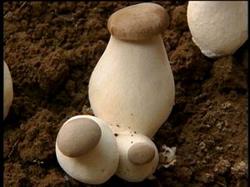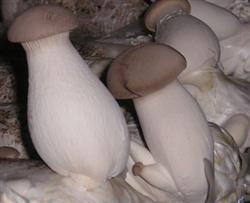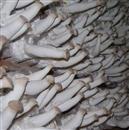New technology of planting Pleurotus eryngii on land cover

First, strain selection. For export products, strains with round shape, uniform stalk, white color, dense tissue and good taste should be selected. Through the experiment, "Xingbao No. 1" introduced from Fujian Edible Fungi Station has the characteristics of thick meat, crisp and tender texture, beautiful appearance and high qualified rate of export, so it is suitable for covering soil and planting. Second, seasonal arrangement. The suitable temperature for the cultivation of Pleurotus eryngii is 12-18 ℃, and it takes about 40-50 days from bag inoculation to mushroom emergence. Generally, it is suitable to make bags in the middle and last ten days of September. Pleurotus eryngii growth is sensitive to temperature. When the temperature continues above 20 ℃, the mushroom body is easy to shrink, yellowing and rot. Therefore, it is particularly important to arrange the suitable local cultivation season according to the suitable temperature for mushroom production in different altitude areas. Third, the production of bacteria. The growth of mycelium could be promoted by adding 3 grams of peptone to PDA. When the mother seed was cultured under 26 ℃ for 10-13 days, the original seed could grow full of test tube and some cottonseed hull could be added to the culture medium of sawdust wheat bran. The general original seed and cultivated seed could grow full bottle (bag) in 35-40 days under 25 ℃ culture. Fourth, the production of bacterial bags. 1. Raw materials and formulations. There are many suitable growth substrates for Pleurotus eryngii, and the scraps of various agricultural and forestry by-products, such as broad-leaved tree sawdust, cottonseed hull, bagasse, wheat straw, waste cotton, rice straw and straw powder, can be used as the main raw materials for cultivation. Wheat bran, rice bran, corn flour, sugar, calcium carbonate and gypsum powder are auxiliary materials for cultivation of Pleurotus eryngii. Formula 1: cottonseed hull 40%, miscellaneous sawdust 35%, wheat bran 20%, corn meal 3%, sugar 1%, light calcium carbonate 1%, water content 60% Mui 65%, pH 6.0-6.5. Formula 2: cottonseed hull 68%, miscellaneous sawdust 20%, wheat bran 10%, sugar 1%, gypsum powder 1%. 2. Mix and bag. When mixing the material, it can be operated according to the formula proportion according to the conventional method, stirring evenly and then bagging, changing the conventional polyethylene short bag cultivation of 17cm × 34cm specification to the low-pressure polyethylene plastic long bag cultivation of 12cm × 55cm × 0.004 cm specification. Large-scale production in rural areas, long bag cultivation is more suitable, can be bagged by bagging machine, and the production of Lentinus edodes is the same. Fifth, sterilization and vaccination. Put the bag containing the material into the atmospheric stove for the production of Lentinus edodes in time, and strive to reach 100 ℃ in 4-5 hours. Maintain 10-12 hours, generally a stove can produce 6000-8000 bags, after cooling in the inoculation box or sterile room inoculation. The hole punch with a diameter of 2 cm is used to drill 4 holes on one side of the bag, and the inoculum is used to absorb the lump bacteria into the hole, and the plastic bag of 15 cm × 55 cm × 0.002 cm is put on it. The double bag method can effectively reduce the pollution rate. After inoculation with 23-25 ℃ shading culture, it can grow full bag in 40-50 days. | sixth, select a site to set up a shed and arrange the bed. Mushroom farms should choose not to use the fields with ants in the fields with flat terrain, sanitary environment, convenient drainage and irrigation, good water quality and convenient transportation. The outer shed is 2.5 meters high, put on the support with Reed, thatch or Osmunda Osmunda, and surrounded by straw and Reed to create an ecological environment with less light and good cool ventilation. The border in the inner shed is 1.1-1.3 meters long, leaving a walkway 0.5 meters wide, 0.3 meters deep, and every two rows are inserted with bow bamboo, 1.8 meters high, covered with strict plastic film, fumigated with sulfur or sprayed with quicklime to prevent pests and miscellaneous bacteria on the ground, and set aside after disinfection. 7. Go down to the field and cover the soil. After the mycelium grows in the bag and cultured for about 10 days, the bacterial bag can be moved to the pre-prepared mushroom shed, immediately take off the bag, the inoculation hole is facing up, and one bag lies flat on the border surface, covered with a layer of 1-1.5 cm thick soil, the required soil quality should be loose, not easy to solidify, good thermal insulation peat soil. The edge of the bacterial bag border should be sealed with rotten mud to prevent mushrooms from growing on the bottom. 8. Mushroom production management. After the bacteria bag is put into the field, first pour water into the furrow, and immediately drain the water after flooding to the border surface. It is usually appropriate to keep the border surface moist, and do not spray water directly on the mushroom body, otherwise the mushroom will turn yellow and the quality will decline. Serious cases will cause mushroom body rot. When the temperature of the mushroom farm is lower than 10 ℃, it is necessary to take heat preservation measures, cover the mushroom shed cover, close the north doors and windows at night to prevent the north wind from attacking the mushroom farm, and open the doors and windows at noon when the temperature is high, and use the light adjustment to increase the temperature in the mushroom farm; when the mushroom farm temperature is higher than 20 ℃, take cooling measures, open the doors and windows in the morning and evening, close all doors and windows at noon, and spray water on the top of the shade shed if necessary. With the growth of the mushroom body, it is necessary to increase the ventilation rate and the number of ventilation times to ensure the fresh air in the mushroom farm. Such as poor ventilation, it is easy to produce deformed mushrooms, especially in the case of high temperature and humidity, mushroom body is easy to be infected by bacteria and rot; mushroom body growth needs a certain amount of scattered light, light regulation and control is generally combined with the level of air temperature for operation. 9. Harvest and processing. When the edge of the mushroom cover is slightly inward-curled, the color becomes lighter, when the spores are not ejected, it is harvested early, the mushroom body has good flavor and the shelf life is long. Export mushrooms are required to cover 2.5-4 cm in diameter, 6-10 cm in length and 2-4 cm in diameter. Gloves should be worn when harvesting, the mushroom body should be wrung off, and the base impurities should be cut off with a knife. After the first batch of harvest, clean the material surface, replenish the moisture and nutrients in the mushroom bag in time, adjust the temperature and humidity of the mushroom shed, and grow the second tide mushroom in about 10 days, generally growing 2-3 tides: but the yield is mainly concentrated in the first tide Pleurotus eryngii can be sold after 2-4 ℃ cold storage, which is longer than the general mushroom preservation time, and can also be sliced, dried or processed into salted products and cans.
- Prev

Common problem analysis of Pleurotus eryngii
Pleurotus eryngii is one of the edible fungi developed in China in recent years. Its production cycle is short, effective is fast, economic benefit is relatively high, and the planting area is expanding continuously. However, some problems often occur in the production of Pleurotus eryngii, which cause huge losses to mushroom farmers, so we must pay attention to them. I. Bacterial bag pollution caused by...
- Next

Cultivation techniques of Pleurotus eryngii
Apricot abalone mushroom (Pleurotuseryngii) is also known as snow mushroom. Pleurotus eryngii is a kind of large fleshy umbrella fungus with good quality. Pleurotus eryngii has thick seedling meat, crisp and tender texture and delicious taste, which can be called the king of Pleurotus ostreatus. Rich in nutrition, high oligosaccharide content, has the effect of bowel cosmetology. It can be suitable for keeping fresh or dried, and is very popular with consumers.
Related
- Fuxing push coffee new agricultural production and marketing class: lack of small-scale processing plants
- Jujube rice field leisure farm deep ploughing Yilan for five years to create a space for organic food and play
- Nongyu Farm-A trial of organic papaya for brave women with advanced technology
- Four points for attention in the prevention and control of diseases and insect pests of edible fungi
- How to add nutrient solution to Edible Fungi
- Is there any good way to control edible fungus mites?
- Open Inoculation Technology of Edible Fungi
- Is there any clever way to use fertilizer for edible fungus in winter?
- What agents are used to kill the pathogens of edible fungi in the mushroom shed?
- Rapid drying of Edible Fungi

